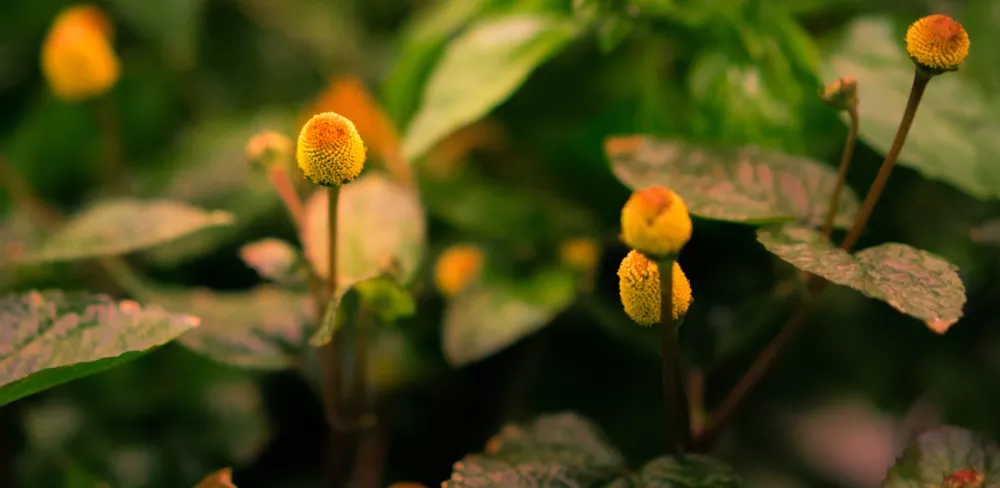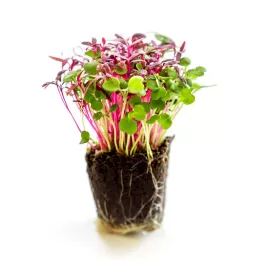“I can’t feel my mouth.” “I’m drooling.” “Yelp.” “What? What is this?” “It’s salty.” “Sichuan peppercorn?” “My tongue is all numb down one side.”
“Will I ever be normal again?”
“I like it.” “I don’t like it.” The toothache button fascinates me. It seems to sit on the edge of danger. The rest of the culinary plant world is so “safe” and well-defined. The traditional French herb garden has such an air of familiarity that it verges on boring. The toothache plant, however, is different.
The red-and-yellow buttons of the toothache plant (which are actually collections of dozens of miniscule flowers) poke out of lush, dark-green foliage. They are part of a cluster, arranged on a stem composed of multiple branches, and rather strange-looking — the sort of thing you might see in Alice in Wonderland. If you came across it for the first time in its native Amazon, where it is known as “jambu,” you would almost certainly avoid it — its bold colors suggest a little bit (or a lot) of danger.
But inside ICE’s hydroponic garden, where we are growing the toothache plants in a highly controlled setting, you can step out of your comfort zone and try it. The buttons, stems and leaves can be eaten, and deliver a surprising, slowly revealed but long-lasting effect. Some describe it as a numbing sensation. Others find a grassy note, followed by a rush of saliva. Others simply can’t find words to explain the feeling, so resort to mumbling and drooling.
And this is why I love it
It’s like a drug experience without the illegality or potential danger. Before they taste the plant, I typically ask people, “Are you adventurous?” and it’s a moment of pure honesty. Those who genuinely are will dive in. Those who aren’t adventurous will say “no” in order to protect themselves, and delay the inevitable (tasting). There are few liars. After the first bite of the toothache plant, there’s a good 10-second period where nothing happens. The taster will ask: Is it working?
They question whether it’s legit. Then the effects start to appear, effects that reveal themselves differently from person to person. Some people experience a lot and reveal nothing. Others show every sensation through facial expressions, as the mind attempts to process what is happening. Some tasters worry: Will this last forever?Will I be forever altered? Some are content to just enjoy the ride. Others try to control it. There are no other herbs that do this — that take you on a journey. This is why I love this plant so much. In a small way, it reveals who we are.
Origins and Botany
The plant’s latin name is Acmella/Spilanthes Oleracea, but it’s also sometimes known as the electric daisy, paracress, buzz buttons, Sichuan buttons and most often as toothache plant. Though the toothache plant is part of the Sunflower family (Asteraceae), its effects are clearly very different. The toothache plant is a perennial that can be harvested yearly. It thrives in warmer climates and, like us, struggles during the frosty winter months. Temperature sensitivity is not a problem here at ICE, where our hydroponic garden is kept at a balmy, rainforest-like 75°F.
Culinary Uses
Jambu is certainly an oddity and even experienced chefs can struggle to find a use for an ingredient that has such a powerful, unusual effect on the palette. We’ve seen it more commonly used in desserts and drinks, matched perhaps with a touch of chili for heat or with something sweet.
You can shred a handful of small, fresh leaves to add an interesting note to a salad. When cooked, the leaves become mild and are served as a Brazilian version of regular greens. The flowers and leaves are also commonly made into oil for use as a flavor extract.
Medicinal & Other Uses
If you’re not keen on its taste, you might be reassured that the toothache plant has numerous other uses. Although new to the U.S., the toothache plant has been utilized medicinally by Asian, African and South American countries throughout history, for its antimicrobial, insecticidal, anti-inflammatory, antiviral, antimalarial, analgesic, anesthetic and vasorelaxant properties.
Sure, the name toothache might not be the most appealing, but it actually derives from its ability to relieve mouth pain, i.e. toothaches and stomatitis, by inciting a unique, tingly, numbing sensation. This feeling is primarily caused by an alkaloid, “spilanthol,” which increases salivation, thereby producing an analgesic effect. Perhaps tooth-ease plant might have been a more appropriate and attractive name. Additionally, in India, toothache plant leaves have been a regular addition to chewing tobacco.
For a new approach to experiencing the toothache plant, ICE Chef Instructor Jenny McCoy came up with a unique recipe using the leaves. Chef Jenny notes, “One of my favorite cocktails is the absinthe-based Green Beast, which would be perfect to pair with the toothache plant. Absinthe is mind-numbing and jambu is tooth-numbing, so with a splash of bright lime juice and cooling cucumber, this drink is amazingly balanced.” Try if you dare. We guarantee it will create a stir.
The Greener Beast Cocktail
Servings: makes one cocktail
Ingredients:
- 1 ounce absinthe
- 1 ounce fresh lime juice
- 1 ounce simple syrup
- 2-4 ounces seltzer
- 1 sprig of toothache plant
- A couple of cucumber slices
Preparation
- Combine the first four ingredients, stir, and pour into a Collins glass filled with ice.
- Garnish with cucumber slices and toothache plant.
See the reaction of Chloe Coscarelli — the popular vegan chef and chef-owner of By Chloe — as she tastes jambu for the first time.
Where can you try Toothache? At Farm.One here at ICE we keep a few plants around for the fun factor and we grow to order for sale in NYC. If you have the chance to visit us, ask for a taste. You might just discover something about yourself.Want to cultivate your green thumb at ICE? Click here for more information on ICE’s career programs




